How to Build a Proactive AI Agent for Business Growth?
In today’s fast-paced business landscape, leveraging technology is essential for staying competitive, and building a proactive AI agent can significantly drive growth. A proactive AI agent goes beyond reactive responses; it anticipates market trends, identifies opportunities, and enhances decision-making processes. To create such an agent, businesses must first define clear objectives that align with their growth strategy. Understanding the specific needs of the organization and the industry landscape is crucial for designing an effective AI solution. Next, data becomes the foundation for collecting, cleaning, and analyzing relevant data sets ensuring the AI agent operates on accurate insights.
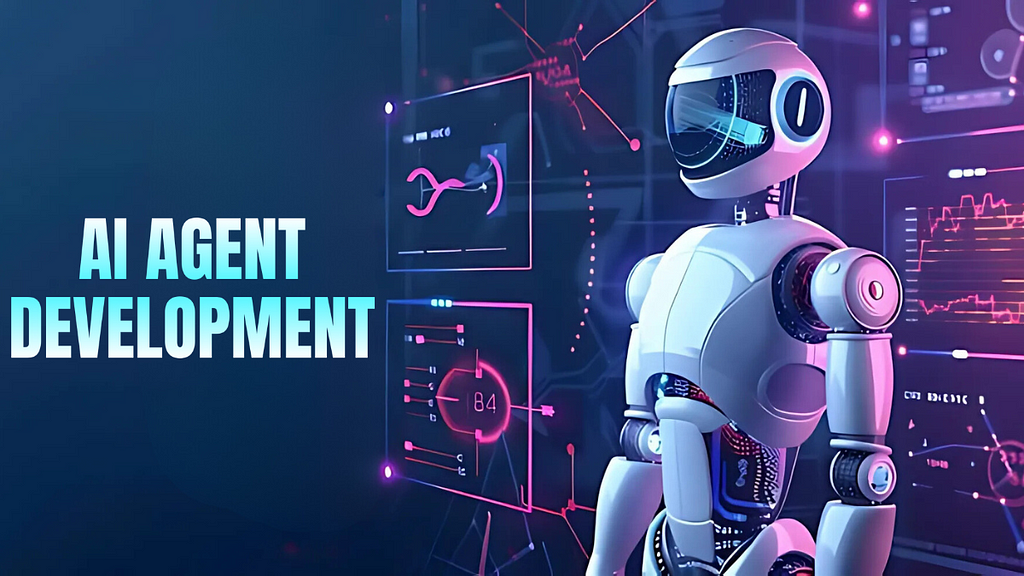
Incorporating machine learning algorithms enables the agent to learn from patterns and make informed predictions. Moreover, integrating the AI agent with existing business systems enhances its functionality, allowing for seamless workflows and improved efficiency. Finally, continuous monitoring and iteration are vital for adapting to changing market dynamics and refining the agent’s capabilities. By focusing on these key steps, businesses can build a proactive AI agent development that not only drives growth but also positions them as leaders in their respective markets.
Table of ContentWhat is AI Agent Development?Understanding Proactive AI Agents
Type of Proactive AI Agent
How Do AI Agents Work?
Key Components of a Proactive AI Agent
Key Steps in Building a Proactive AI Agent
Challenges and Considerations
Future Trends in Proactive AI
ConclusionWhat is AI Agent Development?
AI agent development refers to the process of creating intelligent software agents capable of performing tasks autonomously or semi-autonomously, often by leveraging artificial intelligence and machine learning technologies. These agents can analyze data, learn from experiences, and make decisions based on predefined objectives or real-time inputs. The development process typically begins with defining the agent’s purpose, which could range from customer service automation to data analysis or even predictive maintenance in industrial settings.
Once the objectives are established, developers focus on gathering and preprocessing relevant data, as high-quality data is crucial for training effective AI models. Various algorithms and frameworks are then employed to build the agent’s underlying architecture, enabling it to learn from historical data and adapt to new information.
Additionally, integrating the AI agent with existing systems and ensuring seamless communication between various components is vital for achieving its intended functionality. Finally, rigorous testing and iteration are essential to refine the agent’s performance and ensure it meets business goals, ultimately delivering value by enhancing efficiency, improving user experiences, and driving informed decision-making.
Understanding Proactive AI AgentsProactive AI agents are advanced systems designed to anticipate needs and act on opportunities before they arise, distinguishing them from reactive agents that only respond to events as they occur. These intelligent agents utilize machine learning algorithms and predictive analytics to analyze data patterns, forecast trends, and generate actionable insights. By continuously learning from their environment and user interactions, proactive AI agents can adapt their strategies and improve their decision-making over time. This forward-thinking approach allows them to identify potential challenges or opportunities early, enabling businesses to take preemptive actions that enhance efficiency and drive growth.
For example, in customer service, a proactive AI agent might predict when a customer is likely to need assistance and reach out with solutions before the customer even asks. Similarly, in supply chain management, it can forecast inventory shortages and trigger restocking processes ahead of time. By leveraging proactive AI agents, organizations can not only improve operational efficiency but also enhance customer satisfaction, making them a vital component in modern business strategies focused on innovation and competitiveness.
Type of Proactive AI AgentProactive AI agents can be categorized based on their functionalities, applications, and the domains they serve. Here are some common types of proactive AI agents:
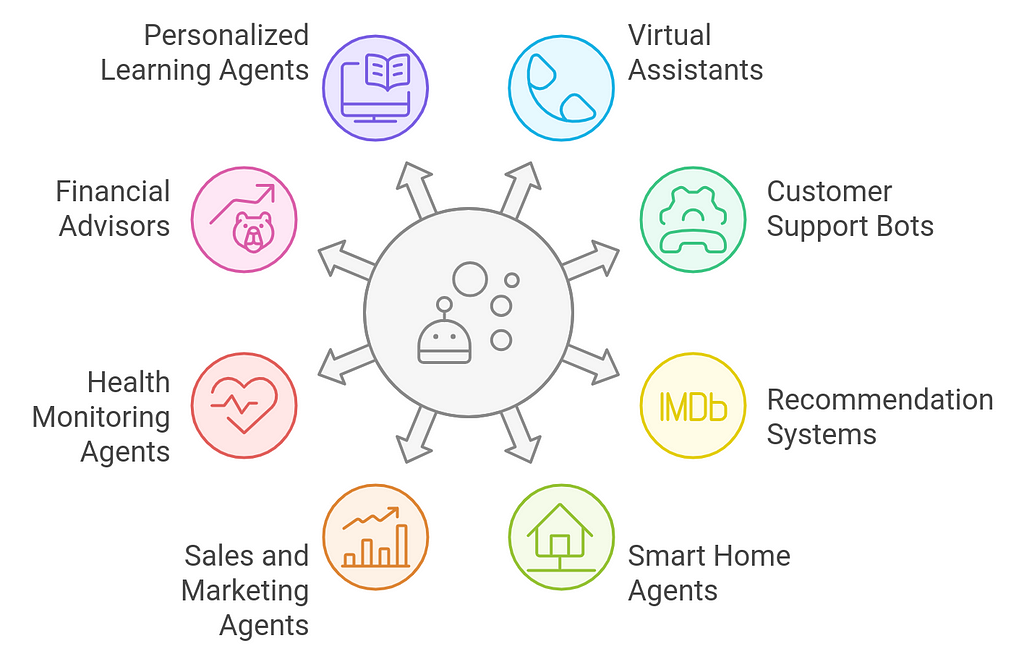 1. Virtual Assistants
1. Virtual Assistants- Examples: Amazon Alexa, Google Assistant, Apple Siri
- Functionality: These agents assist users with daily tasks such as setting reminders, managing calendars, providing weather updates, and answering questions. They proactively suggest actions based on user habits.
- Examples: Chatbots on websites or messaging platforms
- Functionality: These AI agents handle customer inquiries, provide troubleshooting assistance, and offer product recommendations. They often anticipate user needs based on previous interactions and frequently asked questions.
- Examples: Netflix, Spotify, Amazon
- Functionality: These agents analyze user preferences and behavior to suggest relevant content (movies, music, products). They proactively present options that align with users’ tastes and interests.
- Examples: Google Nest, Smart thermostats, Philips Hue
- Functionality: These agents manage home automation systems, learning user routines to adjust settings (like temperature, lighting, and security) automatically, enhancing comfort and energy efficiency.
- Examples: AI-driven CRM systems
- Functionality: These agents analyze customer data to identify leads, personalize marketing campaigns, and suggest upselling opportunities, proactively engaging with potential clients.
- Examples: Wearable health devices, telehealth applications
- Functionality: These agents monitor user health metrics (like heart rate, sleep patterns) and provide proactive recommendations for lifestyle changes or alerts when irregularities are detected.
- Examples: Robo-advisors (like Betterment or Wealthfront)
- Functionality: These agents analyze financial data to provide personalized investment advice, budget suggestions, and proactive alerts about market changes or investment opportunities.
- Examples: Adaptive learning platforms (like Duolingo, Khan Academy)
- Functionality: These agents tailor educational content to individual learners, providing recommendations and reminders based on their progress and learning styles.
- Examples: Tools like Zapier or Microsoft Power Automate
- Functionality: These agents automate repetitive tasks by integrating various applications, allowing users to set triggers that initiate workflows automatically based on specific conditions.
- Examples: AI tools for managing social media accounts (like Hootsuite or Buffer)
- Functionality: These agents analyze social media trends and user interactions to suggest optimal posting times, content ideas, and engagement strategies.
- Examples: Travel planning apps like TripIt or Google Trips
- Functionality: These agents help users plan trips by providing proactive suggestions for itineraries, accommodation, and activities based on user preferences and travel history.
- Examples: AI in video games (like NPCs with adaptive behavior)
- Functionality: These agents proactively adjust gameplay based on user skills and preferences, providing personalized challenges and experiences to enhance engagement.
These various types of proactive AI agents serve different functions across multiple industries, each designed to improve user experience, efficiency, and engagement by anticipating needs and taking initiative.
How Do AI Agents Work?AI agents operate through a combination of algorithms, data processing, and interaction mechanisms to perform tasks and make decisions. Here’s a breakdown of how AI agents work, including their components and processes:
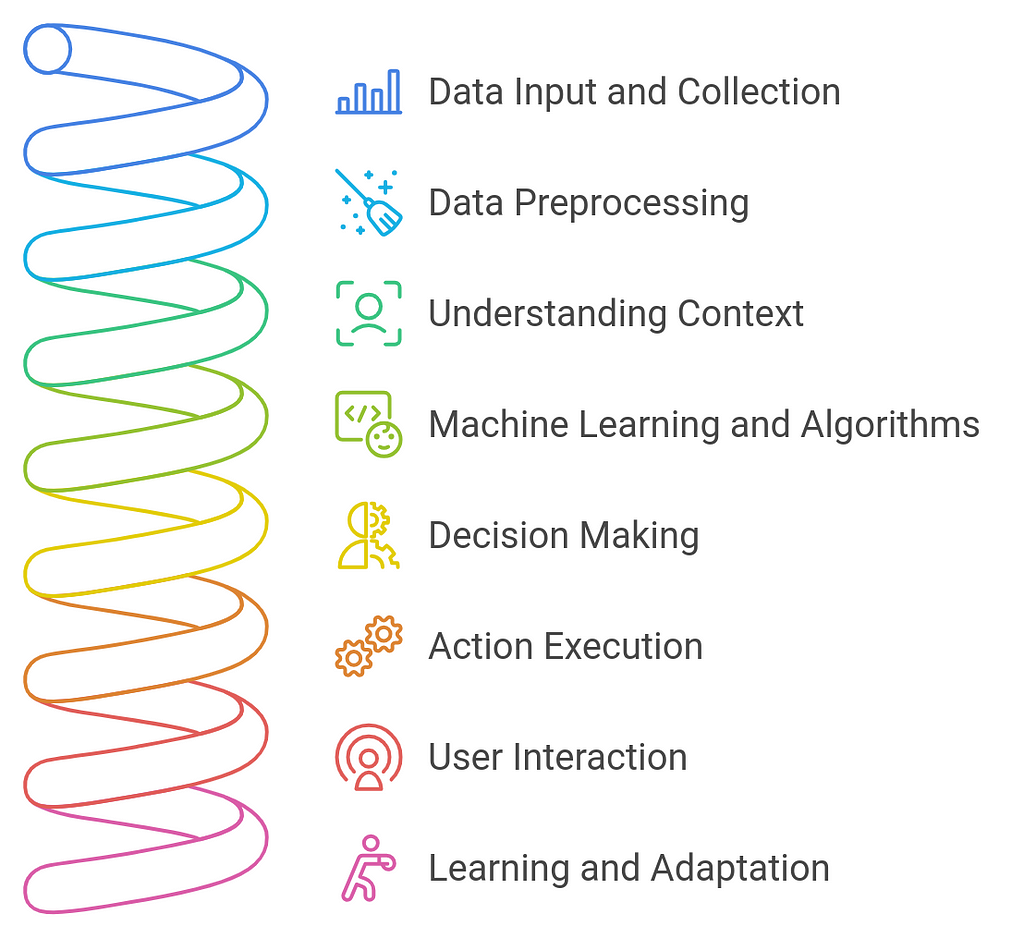 1. Data Input and Collection
1. Data Input and Collection- Sources of Data: AI agents collect data from various sources, such as user inputs (text, voice, actions), sensors (in smart devices), external databases, or APIs.
- Types of Data: This data can include historical interactions, user preferences, contextual information, and environmental factors.
- Cleaning: The data is cleaned to remove inconsistencies, errors, or irrelevant information, ensuring high-quality input for analysis.
- Normalization: Data is transformed into a standard format to facilitate effective analysis and model training.
- Feature Extraction: Key characteristics (features) are identified from the raw data to help the agent understand and process the information.
- Context Awareness: AI agents analyze the context surrounding user interactions, such as time, location, and user activity, to provide relevant responses or suggestions.
- User Profiling: The agent maintains a profile of the user, tracking preferences, habits, and past interactions to enhance personalization.
- Model Training: AI agents are trained using various machine learning algorithms, such as supervised, unsupervised, or reinforcement learning. This training involves using historical data to help the agent learn patterns and make predictions.
- Natural Language Processing (NLP): For text or voice-based interactions, NLP techniques are applied to understand and generate human language, enabling the agent to interpret queries and respond appropriately.
- Inference Engine: The agent uses an inference engine to analyze input data, applying learned models and rules to make decisions or predictions based on the current context.
- Proactive Behavior: The agent anticipates user needs and can take actions autonomously, such as sending reminders or suggesting solutions based on predicted user behavior.
- Task Automation: Once a decision is made, the AI agent executes actions, which could involve responding to user queries, sending notifications, or controlling connected devices (in the case of smart home agents).
- Integration with Systems: Proactive AI agents often integrate with other software systems or platforms (like CRMs or IoT devices) to perform tasks effectively.
- Communication: AI agents interact with users through various interfaces, such as chatbots, voice commands, or applications, depending on the intended use case.
- Feedback Loop: Users provide feedback on the agent’s performance, allowing the system to learn and adapt over time.
- Continuous Learning: AI agents can update their models based on new data and user feedback, improving their performance and accuracy over time.
- Reinforcement Learning: Some agents employ reinforcement learning, where they learn from the consequences of their actions, adjusting their strategies to maximize positive outcomes.
- Decision Transparency: Ethical AI agents provide explanations for their decisions, ensuring users understand how and why certain actions are taken.
- Data Privacy: AI agents implement measures to protect user data and comply with regulations, maintaining user trust and safety.
- Performance Monitoring: AI agents are regularly monitored for performance, accuracy, and user satisfaction to identify areas for improvement.
- Updates and Maintenance: Ongoing updates are applied to keep the agent current with technological advancements and user needs.
By integrating these components and processes, AI agents can effectively assist users, automate tasks, and enhance decision-making across various applications and industries.
Key Components of a Proactive AI AgentA proactive AI agent is designed to anticipate user needs and take the initiative to fulfill them, rather than simply reacting to explicit requests. Here are the key components that make up a proactive AI agent:
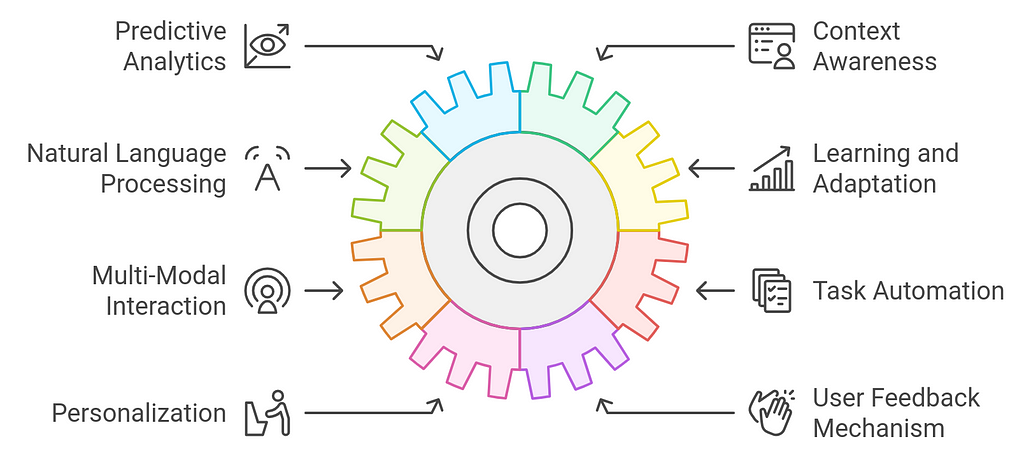 1. Predictive Analytics:
1. Predictive Analytics:- Utilizes data analysis and machine learning to forecast user behavior and preferences. This allows the agent to provide suggestions or take actions before the user explicitly asks for them.
- Understands the environment and situation of the user. This includes recognizing time, location, and user activity to offer timely and relevant assistance.
- Enables the agent to understand and generate human language, facilitating smooth communication with users. This includes sentiment analysis to gauge user emotions and adjust responses accordingly.
- Employs reinforcement learning and other techniques to improve its performance over time based on user interactions and feedback. This helps the agent refine its proactive suggestions.
- Supports various forms of interaction, such as voice, text, and visual input. This flexibility allows users to communicate with the agent in their preferred way.
- Capable of performing tasks on behalf of users, such as scheduling appointments, sending reminders, or managing workflows, without requiring user intervention.
- Customizes the user experience by adapting its behavior and recommendations based on individual user profiles, preferences, and past interactions.
- Incorporates a system for users to provide feedback on the agent’s actions and suggestions, helping the agent improve and align better with user expectations.
- Operates with clear ethical guidelines and transparency, ensuring that users understand how decisions are made and data is used. This fosters trust in the agent.
- Can seamlessly connect with other applications and services (e.g., calendars, emails, IoT devices) to gather data and execute tasks efficiently.
These components work together to create an AI agent that can proactively engage with users, enhancing their experience and productivity while minimizing the need for explicit commands.
Key Steps in Building a Proactive AI AgentBuilding a proactive AI agent involves a systematic approach that combines several disciplines, including machine learning, natural language processing, and user experience design. Here are the key steps in the development process:
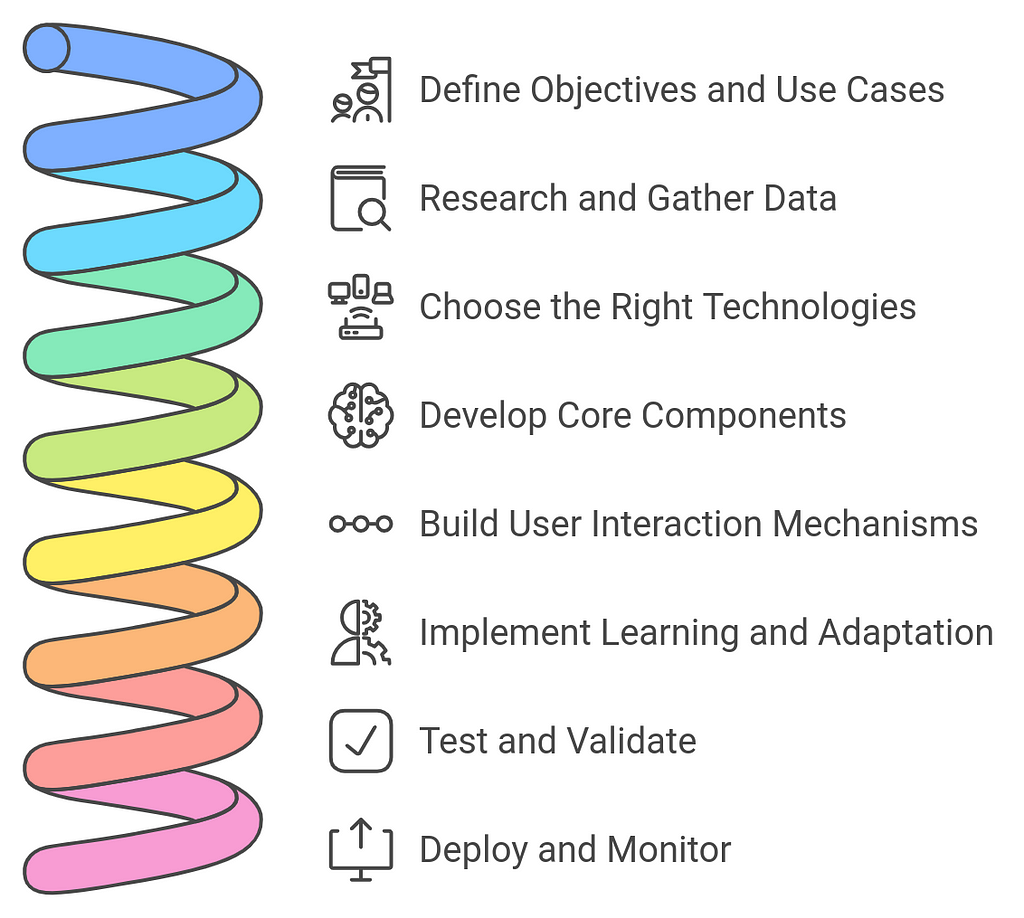 1. Define Objectives and Use Cases
1. Define Objectives and Use Cases- Identify Goals: Clearly outline what the proactive AI agent should achieve, such as improving user productivity or enhancing customer support.
- Select Use Cases: Determine specific scenarios in which the agent will operate, ensuring they align with user needs and business objectives.
- Data Collection: Accumulate relevant data for training the AI model, including historical user interactions, preferences, and contextual information.
- Data Quality Assessment: Ensure the data is accurate, clean, and representative of real-world conditions to improve the model’s performance.
- Select Frameworks and Tools: Decide on the technologies and platforms to use, such as machine learning libraries (e.g., TensorFlow, PyTorch) and NLP tools (e.g., spaCy, NLTK).
- Infrastructure Setup: Establish the necessary computational resources, such as cloud services or on-premises servers, for model training and deployment.
- Predictive Modeling: Create algorithms that utilize machine learning techniques to predict user behavior and needs.
- Natural Language Processing: Implement NLP capabilities to enable the agent to understand and respond to user queries effectively.
- Contextual Awareness: Integrate context-awareness features that allow the agent to adapt its behavior based on user conditions and environments.
- Design User Interfaces: Create intuitive interfaces (voice, chat, or visual) that facilitate user interaction with the agent.
- Multi-Modal Support: Ensure the agent can handle various input forms, allowing users to engage through their preferred channels.
- Reinforcement Learning: Incorporate algorithms that enable the agent to learn from user feedback and adjust its actions over time.
- Personalization Mechanisms: Develop features that allow the agent to tailor its responses and suggestions based on individual user profiles.
- Usability Testing: Conduct user testing to evaluate the agent’s effectiveness, usability, and overall experience.
- Performance Evaluation: Measure the model’s accuracy, response times, and predictive capabilities using metrics appropriate for the application.
- Deployment Strategy: Launch the proactive AI agent in a controlled environment or pilot program before full-scale deployment.
- Monitoring and Maintenance: Continuously monitor the agent’s performance, gather user feedback, and implement updates or improvements as necessary.
- Data Privacy: Implement robust data protection measures to safeguard user information and comply with relevant regulations (e.g., GDPR).
- Transparency: Communicate how the agent works and how decisions are made, fostering trust with users.
- Feedback Loop: Establish mechanisms for collecting user feedback and performance data to guide ongoing improvements.
- Continuous Learning: Regularly update the model and features based on new data and evolving user needs to keep the agent relevant and effective.
By following these steps, you can create a proactive AI agent that meets user expectations, enhances engagement, and adds significant value to the user experience.
Challenges and ConsiderationsDeveloping proactive AI agents presents several challenges and considerations that organizations must navigate to ensure successful implementation. One primary challenge is the quality and availability of data; AI agents rely heavily on accurate and comprehensive data for training and decision-making. Inconsistent or biased data can lead to flawed insights and poor performance. Additionally, the complexity of integrating AI agents into existing systems can pose significant technical hurdles, requiring specialized skills and resources.
Organizations must also address ethical concerns, such as data privacy and algorithmic bias, to ensure that their AI agents operate transparently and fairly. Moreover, establishing clear objectives and defining the scope of the AI agent’s capabilities is crucial; overambitious goals can lead to project failures or misaligned expectations.
Finally, ongoing monitoring and maintenance are essential to adapt the AI agent to evolving business needs and market conditions. By proactively addressing these challenges, organizations can maximize the benefits of their AI agents and drive sustainable growth.
Future Trends in Proactive AIThe future of proactive AI is poised to evolve significantly, driven by advancements in technology, changing user expectations, and the growing need for automation. Here are some key trends likely to shape the landscape of proactive AI in the coming years:
 1. Enhanced Personalization
1. Enhanced Personalization- Tailored Experiences: AI agents will become more adept at personalizing interactions based on individual user profiles, preferences, and behaviors, offering highly customized recommendations and solutions.
- Adaptive Learning: Continuous learning algorithms will allow agents to adapt in real-time to user changes, improving the relevance of their responses.
- Conversational AI: Advances in NLP will lead to more natural, human-like conversations, making interactions with AI agents smoother and more intuitive.
- Contextual Understanding: Future AI agents will better understand context, sentiment, and nuances in user communication, enabling them to respond appropriately in various situations.
- Voice, Text, and Visual Inputs: Proactive AI will increasingly support multiple forms of interaction (voice, text, images), allowing users to communicate in their preferred manner.
- Augmented Reality (AR) and Virtual Reality (VR): AI agents will leverage AR and VR technologies to create immersive experiences, such as virtual shopping assistants or interactive learning environments.
- Self-Learning Systems: Future AI agents will utilize advanced machine learning techniques to operate with greater autonomy, making decisions based on user behavior patterns without needing explicit instructions.
- Complex Problem Solving: AI agents will be capable of addressing more complex tasks and providing sophisticated solutions, especially in fields like healthcare, finance, and logistics.
- Ecosystem Integration: Proactive AI will integrate seamlessly with a broader range of devices and platforms, creating a unified user experience across smart homes, wearables, and mobile applications.
- Interoperability: Agents will be designed to work together across different systems, enhancing collaboration and information sharing among applications.
- Transparency and Explainability: There will be a stronger emphasis on ethical AI practices, with a focus on transparency in decision-making processes and the ability for users to understand how recommendations are made.
- Data Privacy and Security: Proactive AI will implement robust measures to ensure user data privacy, compliance with regulations, and protection against potential misuse.
- Forecasting Capabilities: AI agents will leverage advanced predictive analytics to provide users with insights and recommendations before issues arise, enhancing proactive problem-solving.
- Behavioral Prediction: By analyzing user behavior, AI agents will anticipate needs and suggest actions, such as scheduling tasks or alerting users to potential risks.
- Wellness Monitoring: Proactive AI will play a significant role in mental health support by monitoring user emotions and behaviors, offering personalized interventions and coping strategies.
- Virtual Companions: AI agents designed as virtual companions will help users manage stress and loneliness, providing support through conversation and engagement.
- Augmented Intelligence: AI agents will work alongside human professionals in various sectors (e.g., healthcare, customer service), enhancing their capabilities and providing valuable support.
- Hybrid Models: Proactive AI will facilitate a hybrid approach where human input is combined with AI efficiency to improve outcomes in decision-making processes.
- Resource Optimization: Future AI agents will focus on sustainability, optimizing resource usage in various sectors (e.g., energy management, supply chain logistics) to minimize environmental impact.
- Smart Cities: Proactive AI will contribute to the development of smart cities, enhancing urban planning, traffic management, and public services through intelligent data analysis and automation.
These trends indicate that proactive AI will become increasingly integrated into daily life, enhancing user experiences and transforming various industries. As technology advances, the capabilities and applications of proactive AI will expand, leading to more effective and intuitive interactions between humans and machines.
ConclusionIn conclusion, building a proactive AI agent is not just a technological endeavor; it’s a strategic initiative that can transform how a business operates and grows. By embracing advanced AI capabilities, organizations can harness the power of predictive analytics to anticipate customer needs, streamline operations, and uncover new market opportunities. The process begins with a clear understanding of business objectives and the specific challenges that the AI agent aims to address. With the right data at its core, the AI agent can learn and adapt, ensuring that its insights remain relevant and actionable.
Additionally, integrating the agent into existing systems fosters a more cohesive workflow, enhancing collaboration across departments. It’s crucial to maintain a feedback loop for continuous improvement, allowing the AI agent to evolve alongside changing business environments. As organizations invest in the development and refinement of these intelligent agents, they position themselves for sustained growth and innovation. Ultimately, a proactive AI agent can catalyze long-term success, enabling businesses to stay ahead of the curve and thrive in an increasingly competitive landscape.
How to Build a Proactive AI Agent for Business Growth? was originally published in Coinmonks on Medium, where people are continuing the conversation by highlighting and responding to this story.
